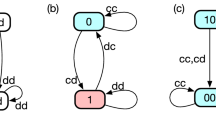Abstract
We study the finitely repeated prisoner’s dilemma in which the players are restricted to choosing strategies which are implementable by a machine with a bound on its complexity. One player has to use a finite automaton while the other player has to use a finite perceptron. Some examples illustrate that the sets of strategies which are induced by these two types of machines are different and not ordered by set inclusion. Repeated game payoffs are evaluated according to the limit of means. The main result establishes that a cooperation at almost all stages of the game is an equilibrium outcome if the complexity of the machines the players may use is limited enough and if the length T of the repeated game is sufficiently large. This result persists when more than T states are allowed in the player’s automaton. We further consider a variant of the model in which the two players are restricted to choosing strategies which are implementable by perceptrons and prove that the players can cooperate at most of the stages provided that the complexity of their perceptrons is sufficiently reduced.
Similar content being viewed by others
References
Abreu D., Rubinstein A. (1988) The structure of Nash equilibria in repeated games with finite automata. Econometrica 56: 1259–1281
Aumann, R. J. (Ed.). (1981). Survey of repeated games. In Essays in game theory and mathematical economics in honour of Oskar Morgenstern. Manheim: Bibliographische Institut.
Axelrod R. (1984) The evolution of cooperation. Basic Books, New York
Benoît J.-P., Krishna V. (1987) Nash equilibria of finitely repeated games. International Journal of Game Theory 16: 197–204
Brown N.R. (1997) Context memory and the selection of frequency estimation strategies. Journal of Experimental Psychology: Learning, Memory & Cognition 23: 898–914
Chatterjee K., Sabourian H. (2009) Game theory and strategic complexity. In: Meyers R.A. (ed) Encyclopedia of complexity and system science. Springer-Verlag, New York
Cho I.-K. (1994) Bounded rationality, neural network and folk theorem in repeated games with discounting. Economic Theory 4: 935–957
Cho I.-K. (1995) Perceptrons play the repeated prisoner’s dilemma. Journal of Economic Theory 67: 267–284
Cho I.-K. (1996a) On the complexity of repeated principal agent games. Economic Theory 7: 1–17
Cho I.-K. (1996b) Perceptrons play repeated games with imperfect monitoring. Games and Economic Behavior 16: 22–53
Cho I.-K., Li H. (1999) How complex are networks playing repeated games. Economic Theory 13: 93–123
Devetag G., Warglien M. (2003) Games and phone numbers: Do short-term memory bounds affect strategic behavior. Journal of Economic Psychology 24: 189–202
Engle-Warnick J., Slonim R.L. (2006) Inferring repeated-game strategies from actions: Evidence from trust game experiments. Economic Theory 28: 603–632
Fudenberg D., Maskin E. (1986) The folk theorem in repeated games with discounting or with incomplete information. Econometrica 54: 533–556
Gilboa I., Samet D. (1989) Bounded versus unbounded rationality: The tyranny of the weak. Games and Economic Behavior 1: 213–221
Kalai E. (1990) Bounded rationality and strategic complexity in repeated games. In: Neyman T., Ichiishi A., Tauman Y. (eds) Game theory and applications. Academic Press, San Diego
Kalai E., Stanford W. (1988) Finite rationality and interpersonal complexity in repeated games. Econometrica 56: 397–410
Neyman A. (1985) Bounded complexity justifies the cooperation in the finitely repeated prisoner’s dilemma. Economic Letters 19: 227–229
Neyman A. (1998) Finitely repeated games with finite automata. Mathematics of Operations Research 23: 513–552
Neyman A., Okada D. (2000) Two-person repeated games with finite automata. International Journal of Game Theory 29: 309–325
Pandelaere M., Hoorens V. (2006) The effect of category focus at encoding on category frequency estimation strategies. Memory & Cognition 34: 28–40
Rubinstein A. (1986) Finite automata play the repeated prisoner’s dilemma. Journal of Economic Theory 39: 83–96
Rubinstein A. (1993) On price recognition and computational complexity in a monopolistic model. Journal of Political Economy 101: 473–484
Simon H.A. (1959) Theories of decision-making in economics and behavioral science. American Economic Review 49: 253–283
Weisbuch G. (1990) Complex systems dynamics. Addison-Wesley: Redwood City, CA, USA
Author information
Authors and Affiliations
Corresponding author
Rights and permissions
About this article
Cite this article
Béal, S. Perceptron versus automaton in the finitely repeated prisoner’s dilemma. Theory Decis 69, 183–204 (2010). https://doi.org/10.1007/s11238-009-9158-y
Received:
Accepted:
Published:
Issue Date:
DOI: https://doi.org/10.1007/s11238-009-9158-y




